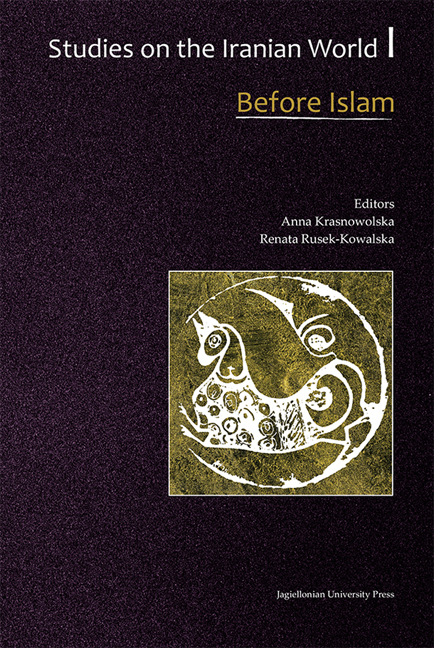Book contents
- Frontmatter
- Contents
- Foreword
- Linguistics
- Literature
- Religion
- History
- Wahrām Čōbīn the Rebel General and the Militarization of the Sasanian Empire
- A Tale of Two Great Kings: Artabanus and Vologaeses
- Realia for Sasanian History: Mint Networks
- New Data on the Development of the Indo-Iranians in the Bronze Age
- Archaeology
New Data on the Development of the Indo-Iranians in the Bronze Age
from History
Published online by Cambridge University Press: 12 January 2018
- Frontmatter
- Contents
- Foreword
- Linguistics
- Literature
- Religion
- History
- Wahrām Čōbīn the Rebel General and the Militarization of the Sasanian Empire
- A Tale of Two Great Kings: Artabanus and Vologaeses
- Realia for Sasanian History: Mint Networks
- New Data on the Development of the Indo-Iranians in the Bronze Age
- Archaeology
Summary
SUMMARY
Gray and Atkinson (2003) dated the initial Indo-European divergence to 7000 BC, but Dyen, Krushkal and others (1992) put it at 3000 BC. This led them to opposite conclusions on the IE homeland. Starostin and Burlak (2005) thought that the disintegration of the IE protolanguage took place in the 3rd millennium BC, but they did not specify where, whether in Anatolia or on the European steppes.
Resolving these problems requires a comparison of linguistic and archaeological data. The common Proto-Indo-European (PIE) word ‘metal’ (cuprum), old Indo-Aryan (IA) ajra- ‘non-cultivated field, pasture’ and PIE agros- ‘pasture’ (Burlak, Starostin 2005, p. 241), the existence of words for cattle, sheep, goat and pig (which fell out of IA and means ‘wild boar’), the horse and its cult, as well as words for oar, wheel and transport, astronomical terms such as ‘Milky Way’, and ‘Coachman’ (Nikonov 1980) all suggest a location for the Indo-European homeland on the banks of major rivers, and reveal the role of wheeled transport in their rapid migrations.
The Iranian languages belong to the Indo-Iranian (IIr) branch of the Indo- European (IE) group. The Old Iranian language was discovered by the French scholar Anquetil-Duperron, who in 1771 published a translation of the Parsees’ religious text, the Avesta. In 1786 the English linguist William Jones demonstrated the links between Sanskrit, Latin, Greek and the Germanic languages. This marked the beginning of Indo-European linguistic studies. However, for 250 years the location of the IE homeland has remained an unsolved problem.
The German scholar August Schleicher (1821–1868) reconstructed the IE protolanguage. His compatriot Otto Schrader (1901) placed the IE homeland in Europe between the Rhein, the Danube and the Dnieper on the basis of certain words connected with the local environment, including the names of wild animals, birds, trees, terms relating to the climate and toponyms in the area. He placed the Indo-Iranians on the Eurasian steppes because of the absence in IIr of words for spruce, pine tree, marsh etc.
Many reconstructions of the IE language tree and the split of PIE have been proposed, and the works of J.P. Mallory (1989; 2002) are now prominent in the field.
- Type
- Chapter
- Information
- Studies on the Iranian World: Before IslamMedieval and Modern, pp. 223 - 236Publisher: Jagiellonian University PressPrint publication year: 2015



